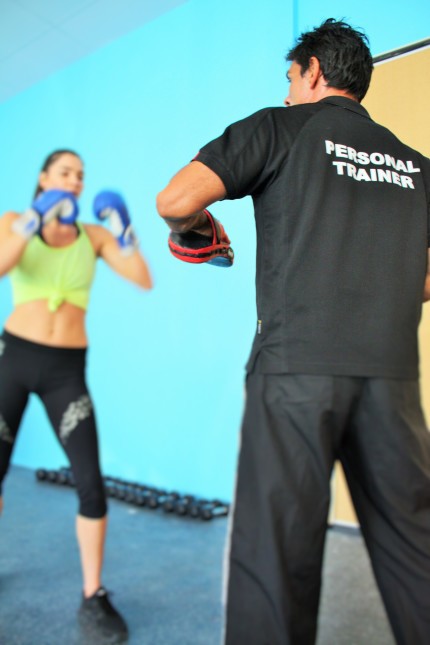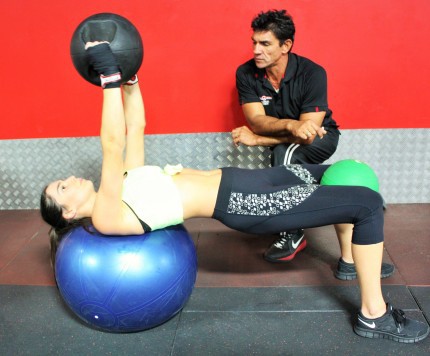Last week I spoke to Jeff about personal training and personal trainers. Today Jeff answers questions from some of you, my readers and friends. If you missed part one you can find it here
 Candice and Jeff. Photo by me,V
Candice and Jeff. Photo by me,V
First question is from Diann.
To lose weight, what ratio of cardio to weight training should women do?
I’ll explain the answer to that question this way. Start with three 40 minute weight sessions a week. I’d probably break it into compound exercises to start with. Compound exercises are when you use more than one muscle group. I would do this program for the first four weeks, including squats, lunges, chest press, lat down, crunches and so on. After each 40 minute weight session clients would then do at least 30 to 40 minutes of cardio. Fast walk, low heart rate burns fat. That depends on what the client has eaten before hand. Don’t eat three hours before training.
After those 4 weeks I’d assess the client and see how much weight they’ve lost. There’s no one fit for every person though. There’s a lot factors to consider here so it would depend heavily on each person. That’s why a trainer needs to tailor programs to suit individual clients.
Question is from Meghan.
What are the best exercises to help regain and strengthen your balance?
This is a great question. I had a client like this once. He was an elderly man, a very successful man. He had brain cancer, vertigo and tinnitus. In order to help him with his vertigo I encouraged him stand and do single leg raises. I would be there if he needed the support. Open chain work we call it. As he progressed I would then get him to do single leg raises and close his eyes. This would take him out of his comfort zone but it did help him to relearn how to correct himself each time. I then focused on core strength, lock himself in with his core muscle group. Some clients get dizzy but if they lock their “core” on it will keep them stable. I taught him “back to basic breathing” and mind techniques.
Then as he started to show improvement single leg raises with single opposite arm raises. Then double arms with single leg raises and throw in “touch your nose with your finger” with the single leg raises.
In the end I had that client on Bondi Beach doing the crane (move from Karate Kid) with his eyes closed.
My Karate Kid Crane
Question from Philip.
What’s your advice on protein powder?
Protein powder is a supplement. It’s not as good a food proteins, chicken, lean meat, egg whites. These foods are a much better source of protein. Clients can have protein supplements after training. When you’ve ripped muscle you have a protein shake straight after so it gets into the muscle and starts healing it straight away. Or for a female wanting to lose weight protein powder can be used as a meal replacement. Protein powder is a great supplement and it is a vital part of a training program depending on what the client is wanting to achieve. Protein powder is a building block to heal and grow. There’s all sorts of different protein powders but at the end of the day they are branded supplements. For a guy training he would look at getting a high protein, high carbohydrate with low salt and sugar in it. A women probably should go for high protein, less carbohydrate, low sugar and low salt.
Question from David.
How important is equipment to training? Do you have to workout with machines to develop muscles?
No. Gymnasts have an even distribution of muscle mass and they are only lifting their own body weight.
But if you want to be bodybuilding, of course, weights and machinery will help you. However, if you just want a good even distribution of muscle mass and a good frame there are hundreds of different exercises that can achieve that result. A good trainer should be able to help someone get great results without machinery if that’s what the clients wants. It’s usually done with a good flow and variation of techniques.
Question from Marg.
What should I expect from an initial assessment?
A high standard. Like I said before a full life health screening. Everything about you and your health. A postural analysis, meaning, do you have one dropped shoulder, scoliosis, overall functional movement and or what side is weak or strong. Sometimes a trainer finds out these things over time, session by session too. Everyone has an imbalance of some kind. A trainer could run a vo2 max test. How much air your muscles are using. It’s done with a bike test. It’s a cardiovascular test. Another test that should be done is a skin fold test by taking specific measurements over your body. It’s a good way to monitor a client’s progress over time.
Question from Helen.
How long should a personal training session be?
Time is money but it’s also education. If a client has a one hour session for example they usually get value for money. An hour is probably prime because it means the session won’t be rushed. The trainer can include a good warmup, a base of exercises and at the end a cool down and a debriefing. If a client can’t afford that then I would get the client to come in and warmup prior to the session themselves. Perhaps a bit of cardio, then 45 minutes of weight work.
Last question is from Beth.
What is the best warmup exercise prior to a personal training session?
Best is a personal choice. If you like to do something and it works stick with it. Walking is a human movement. You can walk short, tall, lazy, fast, walk on your toes or walk sideways. You can walk with good posture and so on. For an older client I’d probably say go with the treadmill with a really good long stride with no arms holding on to anything. Using all limbs, like I say, it’s a human movement and not harmful to the body.
Best being the most helpful, I’d probably go with walking for about 10 minutes. Maybe 4.5 km then take that to 5.5 then up to 6 over that 10 minutes.
For a younger person it would depend on the person. The act of warming up just means taking the body through some exercises to warmup the body. Bike or cross trainer would be an option to do that. Another option could be some star jumps, push ups, walk around the room, squats (nice and easy) and so on. A warm up is taking all the joints through a nice group of basic movements to get blood flow and circulation around the body.
Thank you for sharing all your experience with me and my readers, Jeff.
Thank you for asking me.
Jeff Hall is a trainer at World Gym Ashmore.
See you at the gym. 🙂
So until next time. Be brave and bold in your chosen field of creativity. And never be afraid to explore new techniques.


Thank you for the information, particularly on the protein powder. I have been busy with school and working two jobs lately but I miss being able to work out and feeling good about the way that I look. I also have been thinking about getting a personal trainer as well but I am unsure as I am very busy still. I will have to get back into weight lifting again soon and try some new things that I have been putting off. Thanks again for the article and the advice.
You are most welcome, Zach. Jeff is a great trainer, very knowledgeable and has a wealth of experience. Plus, he a really great guy too. When you find some balance again in your life, and can get back to the gym, a personal trainer might help to motivate you. And most personal trainers, if they are good, will take your work/life balance into account and devise some way to help you. At the moment I’m working on some big deadlines so I can’t get to the gym but Jeff provided me with a list of exercises I can do in conjunction with my cardio I do every day so I don’t lose my strength. Just until I can get back to the gym in a few months. So I do understand when you say you are busy with school and working two jobs, this can happen to all of us, even me. 🙂 Take care. #StayStrong Keep going you’ll make it!